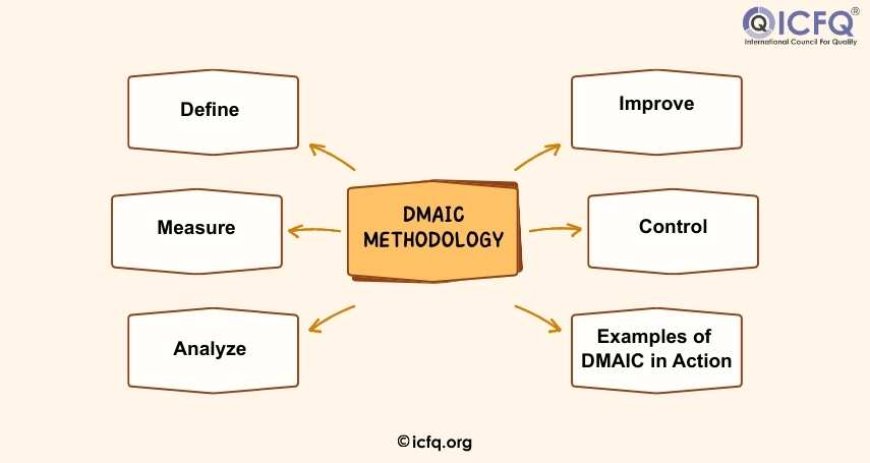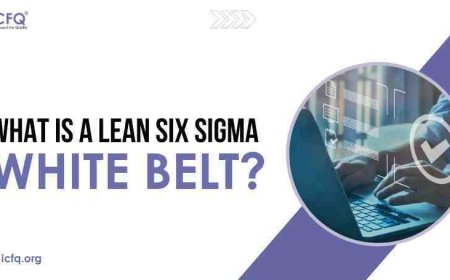Achieving Six Sigma's Black Belt Master Certificate
Become a Six Sigma Black Belt Master with advanced skills in process improvement. Achieve excellence and boost your career with our certification.

Six Sigma methodology is a systematic approach that is full of strategies and techniques designed to make businesses work better. In Six Sigma, we all have to find and fix problems to make everything run smoothly. It's widely recognized for its effectiveness in enhancing efficiency, reducing costs, and increasing customer satisfaction.
Obtaining Six Sigma's Black Belt Master Certificate is a significant achievement in the realm of quality management. It signifies mastery of Six Sigma principles, methodologies, and statistical tools, empowering individuals to lead complex improvement projects within organizations.
Understanding Six Sigma
Six Sigma is a method used by businesses to improve the quality of their processes and products. It originated at Motorola in the 1980s and has since been adopted by many companies worldwide. At its core are a few key principles: focusing on customer needs, using data to make decisions, and aiming for perfection by minimizing defects. This means making sure that products and services meet high standards consistently.
One of the main tools in Six Sigma is the DMAIC methodology, which stands for Define, Measure, Analyze, Improve, and Control. This structured approach guides teams through the process of identifying problems, collecting data, finding solutions, and ensuring that improvements stick. Statistical tools play a crucial role in Six Sigma because they help teams analyze data and make informed decisions. These tools allow businesses to understand where problems are coming from and how to fix them effectively.
Journey To Black Belt Certification
1. Understanding Requirements:
-
Familiarize yourself with the prerequisites for Black Belt certification, which may include completion of prerequisite training and demonstrated proficiency in Six Sigma methodologies.
2. Enrolling in training courses:
-
Identify reputable training programs that offer comprehensive coverage of Six Sigma principles and tools.
-
Enroll in training courses that align with your learning preferences and schedule.
3. Mastering Six Sigma Methodologies:
-
Dedicate time to study and understand Six Sigma methodologies, such as DMAIC (Define, Measure, Analyze, Improve, and Control).
-
Practice applying these methodologies to real-world scenarios to solidify your understanding.
4. Leadership of Improvement Projects:
-
Seek opportunities to lead improvement projects within your organization or community.
-
·Apply Six Sigma principles to drive measurable improvements in processes and outcomes.
5. Successful Project Completion:
-
Complete projects that demonstrate your ability to apply Six Sigma principles effectively.
-
Showcase project outcomes and achievements to validate the practical application of Six Sigma methodologies.
6. Preparing for the Certification Exam:
-
Review exam topics and materials to ensure comprehensive understanding.
-
Practice sample exam questions to familiarize yourself with the format and types of questions asked.
7. Presenting Successful Project Outcomes:
-
Present your successful project outcomes to certification authorities as part of the certification process.
-
Articulate how Six Sigma methodologies were applied to achieve measurable results and drive organizational improvement.
8. Continuous Learning and Improvement:
-
Commit to continuous learning and improvement beyond certification to stay updated on industry trends and best practices.
-
Engage in ongoing professional development activities to enhance your skills and expertise in Six Sigma methodologies.
Embarking on the journey to Black Belt certification requires dedication, perseverance, and a commitment to mastering Six Sigma principles. By following these steps and remaining focused on your goals, you can navigate the certification process successfully and emerge as a proficient leader in quality management and process improvement initiatives.
DMAIC Methodology
-
Define: This phase involves clearly defining the problem and its impact on the organization. It sets the project scope and objectives and identifies stakeholders.
-
Measure: In this phase, data related to the problem are collected and analyzed to establish a baseline. It helps in quantifying the extent of the issue and understanding its causes.
-
Analyze: Here, the collected data is scrutinized to identify patterns, root causes, and potential solutions. Various tools, like root cause analysis, are used to delve deeper into the problem.
-
Improve: Solutions are developed and implemented based on the findings from the analysis phase. The focus is on making changes that address the root causes and lead to measurable improvements.
-
Control: This phase ensures that the improvements made are sustained over time. Control measures and monitoring systems are put in place to prevent the problem from recurring.
-
Examples of DMAIC in Action: A manufacturing company uses DMAIC to reduce defects in its production line, resulting in increased efficiency and cost savings. A healthcare organization implements DMAIC to streamline patient discharge processes, leading to reduced wait times and improved patient satisfaction.

Common Challenges in DMAIC Projects:
Addressing these challenges is crucial for the successful implementation of DMAIC projects and achieving desired outcomes.
-
Difficulty in obtaining accurate data.
-
Resistance to change from team members.
-
Balancing time and resources effectively throughout the project lifecycle.
Statistical Tools and Techniques
Statistical tools are vital in Six Sigma projects for analyzing data and making informed decisions. Commonly used tools include histograms, control charts, regression analysis, and hypothesis testing. Some statistical tools aid in data analysis and Problem-Solving:
-
Histograms visualize data distributions, helping to identify patterns and outliers.
-
Control charts monitor process stability over time, detecting any deviations.
-
Regression analysis explores relationships between variables, aiding in predicting outcomes.
-
Hypothesis testing assesses the significance of observed differences, guiding decision-making.
Practical Examples
-
Using histograms to analyze customer satisfaction survey responses and identify areas for improvement.
-
Employing control charts to monitor defect rates in a manufacturing process and pinpointing when intervention is needed.
-
Conducting regression analysis to understand factors influencing sales performance and optimizing marketing strategies.
Project Management Skills
Project management ensures Six Sigma projects stay on track, within budget, and meet objectives. It helps coordinate resources, manage risks, and maintain stakeholder communication.
-
Stakeholder analysis: identify key stakeholders and manage their expectations.
-
Risk management: identify potential risks and develop mitigation strategies.
-
Communication plans: Ensure clear and effective communication among project team members and stakeholders.
Tips for Effective Project Management:
-
Define clear project goals and objectives from the outset.
-
Develop a detailed project plan outlining tasks, timelines, and responsibilities.
-
Regularly monitor progress against the plan and adjust as necessary.
-
Foster open communication and collaboration among team members.
-
Proactively identify and address potential risks to project success.
-
Ensure stakeholder involvement and buy-in throughout the project lifecycle.
Leadership And Change Management
In Six Sigma Initiatives, leadership provides direction, support, and resources for Six Sigma projects. It sets the tone for an organizational culture focused on quality and continuous improvement. It also has some strategies for managing change:-
-
Communicate the vision: Clearly articulate the purpose and benefits of Six Sigma initiatives to all stakeholders.
-
Empower employees: Involve employees in the change process and provide opportunities for training and development.
-
Lead by example: Demonstrate commitment to Six Sigma principles and practices through actions and behaviors.
-
Address resistance: anticipate and address resistance to change by listening to concerns and providing support.
Exam Preparation and Tips
The preparation for the exam for the Six Sigma Certification needs a proper guide and tips, like reviewing the exam syllabus to understand the topics covered, utilizing study guides and practice exams to familiarize yourself with the exam format and question types, and focusing on understanding key concepts and their practical application in Six Sigma projects.
Tips for Successful Exam-Taking Strategies:
-
Manage your time wisely during the exam by allocating specific time slots for each section.
-
Read each question carefully and ensure you understand what is being asked before answering.
-
Use the process of elimination to rule out incorrect answer choices and increase your chances of selecting the correct one.
-
Review your answers before submitting the exam to catch any errors or overlooked questions.
Resources and Study Materials:
-
Recommended online courses cover Six Sigma principles and methodologies.
-
Practice exams and sample questions are available through certification training providers.
-
Join study groups or forums to discuss exam preparation strategies and share resources with fellow candidates.
In conclusion, by pursuing Six Sigma's Black Belt Master Certificate, from understanding Six Sigma principles to mastering project management and leadership skills, we've laid out the roadmap for success. For those on this journey, keep focused and determined—the rewards are significant.
Earning the Black Belt certification isn't just about acquiring a title; it's about becoming a catalyst for change within your organization. It signifies your expertise in driving improvements and your commitment to excellence. So, stay motivated, keep learning, and continue striving for excellence in your Six Sigma endeavors.





























